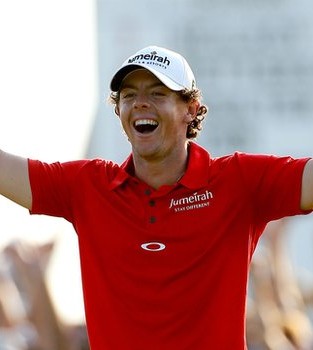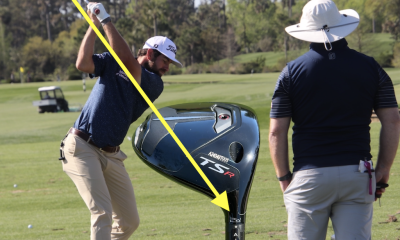Opinion & Analysis
Rory McIlroy isn’t worth $250 million, but he should take it

By Rene Osmena, GolfWRX Contributor
Traditions arrive with much anticipation annually. There’s football, the World Series and new seasons on TV. In the golf world, other yearly rites of passage are circled on the calendar — the cup competitions and the race for tour players to keep their cards. For the most fortunate golfers, there are the big paydays around the globe. However, the wonkiest of golf nuts also recognize the end of the golf season as the sport’s version of the “Hot Stove League.”
You may be saying, “What? Golf is an individual sport, and they’re already free agents!” True, but the close of the PGA Tour’s Fall Series and the conclusion of the European Tour’s Race to Dubai means its time for the “Sponsorship Shuffle,” as companies look to stock their rosters with golf’s rising stars.
This particular re-up period is interesting because Rory McIlroy’s Titleist deal expires at the year’s end. Given Titleist’s history of not overpaying staff players and relying on their dominance in the ball market, they are not likely to offer the kind of money worthy of golf’s current phenom. This makes the 23 year-old Northern Irishman the most coveted soon-to-be free agent since LeBron James. The rumor mill is churning about a certain Swoosh-logoed vulture circling overhead waiting to sweep him up. The latest numbers hint that Nike offered Rory $250 million over 10 years.
That’s A-Rod money! That’s Tiger money! Is he worth that?
According to Golf Digest, Tiger Woods made $62 million in “Off Course” income in 2011 and Rory McIlroy made $5.9 million. One could argue that those numbers should be reversed in the future, considering Rory rose to the No. 1 spot in the Official World Golf Rankings and Tiger failed to win a major championship for the fourth consecutive year. Yes, Tiger bounced back in 2012 with three wins, however, Rory topped him with four wins including a major championship and will end the year as the world’s top-ranked golfer.
Conventional wisdom would then lead one to think, “Rory’s the man now. He is Tiger Woods. Show him the money!” But in one arena Tiger is still the king. People like, no love, watching the dude in the red shirt play golf. They always have, especially when he dominated majors by record margins and willed himself to win the U.S. Open on a broken leg. Now, post scandal, we love Tiger, we hate Tiger, but we still watch Tiger. He’s proven to no longer be immortal in majors, but golf fans either want to watch his comeback or witness his fall.
Rory doesn’t elicit that kind of reaction from the public. They see and appreciate the athletic, graceful swing, the aw-shucks politeness and some fairly dominant golf. But Rory shows a reluctance, more so after Tiger’s troubles, to be the icon at the top. That’s a lot to carry. I firmly believe Rory McIlroy wants to be great; I’m not convinced he wants to be transcendent.
The numbers still show that Tiger is the marquee draw, however. According to Sports Media Watch, televised golf enjoyed its highest ratings in 2012. Tiger played a full schedule for the first time in three years, which led to the surge in viewership. Final round television ratings in Tiger’s three wins (without McIlroy in contention) jumped an average of 161 percent over the previous year. In contrast, when Rory won the PGA Championship, final round ratings were down 17 percent from the previous year (In McIlroy’s other wins, Woods was in contention).
Nike leveraged Tiger’s popularity and built their golf business from the ground up around him. Before Tiger, Nike Golf offered some less-than-stellar golf shirts and golf shoes, but few other products. When Tiger first switched from Titleist, Nike had no clubs or balls in the marketplace. The production of his irons were rumored to have been subcontracted, and his ball was also rumored to be a licensed model from another manufacturer. Now Nike Golf is a truly global golf brand with full product lines and $623 million in gross sales in 2011.
So does Rory deserve Tiger money from Nike? Absolutely not. He’s not only well behind Tiger but arguably behind both Phil Mickelson and Ernie Els in the “needle mover’”category.
So should Nike disregard the numbers and just do it — just hand out the big bucks to McIlroy? Name a Nike player besides Tiger that’s in the Top 10? Top 20? Top 30? Anyone? Buehler???
Francesco Molinari, Charl Schwartzel and Carl Pettersson are ranked Nos. 30, 31 and 32 respectively in the most recent World Golf Rankings. That trio plus Mr. Woods make up all Nike staff players in the Top 50. They are all fine players, but not exactly a star-studded lineup after Tiger. So Nike has a massive void created by the bad bets they placed on David Duval, Anthony Kim, Stewart Cink, Lucas Glover and Paul Casey. Rory can more than fill that void. He’s 13 years younger, and will enter his prime as TW exits stage right for good.
But can rivals like Woods and McIlroy have the same sponsor? If it’s Nike, absolutely! Here’s a few examples of rivals that were under the swoosh at the same time: Agassi and Sampras, Federer and Nadal, Kobe and LeBron, LeBron and Kevin Durant, and even North Carolina and Duke.
The cliché goes, “Timing is everything,” and when you’re the best player in the world and Nike not only wants but needs you, it’s time to get paid. There is no other company that can make Rory their centerpiece and build him into a global brand.
Opinion & Analysis
The 2 primary challenges golf equipment companies face

As the editor-in-chief of this website and an observer of the GolfWRX forums and other online golf equipment discourse for over a decade, I’m pretty well attuned to the grunts and grumbles of a significant portion of the golf equipment purchasing spectrum. And before you accuse me of lording above all in some digital ivory tower, I’d like to offer that I worked at golf courses (public and private) for years prior to picking up my pen, so I’m well-versed in the non-degenerate golf equipment consumers out there. I touched (green)grass (retail)!
Complaints about the ills of and related to the OEMs usually follow some version of: Product cycles are too short for real innovation, tour equipment isn’t the same as retail (which is largely not true, by the way), too much is invested in marketing and not enough in R&D, top staffer X hasn’t even put the new driver in play, so it’s obviously not superior to the previous generation, prices are too high, and on and on.
Without digging into the merits of any of these claims, which I believe are mostly red herrings, I’d like to bring into view of our rangefinder what I believe to be the two primary difficulties golf equipment companies face.
One: As Terry Koehler, back when he was the CEO of Ben Hogan, told me at the time of the Ft Worth irons launch, if you can’t regularly hit the golf ball in a coin-sized area in the middle of the face, there’s not a ton that iron technology can do for you. Now, this is less true now with respect to irons than when he said it, and is less and less true by degrees as the clubs get larger (utilities, fairways, hybrids, drivers), but there remains a great deal of golf equipment truth in that statement. Think about it — which is to say, in TL;DR fashion, get lessons from a qualified instructor who will teach you about the fundamentals of repeatable impact and how the golf swing works, not just offer band-aid fixes. If you can’t repeatably deliver the golf club to the golf ball in something resembling the manner it was designed for, how can you expect to be getting the most out of the club — put another way, the maximum value from your investment?
Similarly, game improvement equipment can only improve your game if you game it. In other words, get fit for the clubs you ought to be playing rather than filling the bag with the ones you wish you could hit or used to be able to hit. Of course, don’t do this if you don’t care about performance and just want to hit a forged blade while playing off an 18 handicap. That’s absolutely fine. There were plenty of members in clubs back in the day playing Hogan Apex or Mizuno MP-32 irons who had no business doing so from a ballstriking standpoint, but they enjoyed their look, feel, and complementary qualities to their Gatsby hats and cashmere sweaters. Do what brings you a measure of joy in this maddening game.
Now, the second issue. This is not a plea for non-conforming equipment; rather, it is a statement of fact. USGA/R&A limits on every facet of golf equipment are detrimental to golf equipment manufacturers. Sure, you know this, but do you think about it as it applies to almost every element of equipment? A 500cc driver would be inherently more forgiving than a 460cc, as one with a COR measurement in excess of 0.83. 50-inch shafts. Box grooves. And on and on.
Would fewer regulations be objectively bad for the game? Would this erode its soul? Fortunately, that’s beside the point of this exercise, which is merely to point out the facts. The fact, in this case, is that equipment restrictions and regulations are the slaughterbench of an abundance of innovation in the golf equipment space. Is this for the best? Well, now I’ve asked the question twice and might as well give a partial response, I guess my answer to that would be, “It depends on what type of golf you’re playing and who you’re playing it with.”
For my part, I don’t mind embarrassing myself with vintage blades and persimmons chasing after the quasi-spiritual elevation of a well-struck shot, but that’s just me. Plenty of folks don’t give a damn if their grooves are conforming. Plenty of folks think the folks in Liberty Corner ought to add a prison to the museum for such offences. And those are just a few of the considerations for the amateur game — which doesn’t get inside the gallery ropes of the pro game…
Different strokes in the game of golf, in my humble opinion.
Anyway, I believe equipment company engineers are genuinely trying to build better equipment year over year. The marketing departments are trying to find ways to make this equipment appeal to the broadest segment of the golf market possible. All of this against (1) the backdrop of — at least for now — firm product cycles. And golfers who, with their ~15 average handicap (men), for the most part, are not striping the golf ball like Tiger in his prime and seem to have less and less time year over year to practice and improve. (2) Regulations that massively restrict what they’re able to do…
That’s the landscape as I see it and the real headwinds for golf equipment companies. No doubt, there’s more I haven’t considered, but I think the previous is a better — and better faith — point of departure when formulating any serious commentary on the golf equipment world than some of the more cynical and conspiratorial takes I hear.
Agree? Disagree? Think I’m worthy of an Adam Hadwin-esque security guard tackle? Let me know in the comments.
@golfoncbs The infamous Adam Hadwin tackle ? #golf #fyp #canada #pgatour #adamhadwin ? Ghibli-style nostalgic waltz – MaSssuguMusic
Podcasts
Fore Love of Golf: Introducing a new club concept

Episode #16 brings us Cliff McKinney. Cliff is the founder of Old Charlie Golf Club, a new club, and concept, to be built in the Florida panhandle. The model is quite interesting and aims to make great, private golf more affordable. We hope you enjoy the show!
Opinion & Analysis
On Scottie Scheffler wondering ‘What’s the point of winning?’

Last week, I came across a reel from BBC Sport on Instagram featuring Scottie Scheffler speaking to the media ahead of The Open at Royal Portrush. In it, he shared that he often wonders what the point is of wanting to win tournaments so badly — especially when he knows, deep down, that it doesn’t lead to a truly fulfilling life.
View this post on Instagram
“Is it great to be able to win tournaments and to accomplish the things I have in the game of golf? Yeah, it brings tears to my eyes just to think about it because I’ve literally worked my entire life to be good at this sport,” Scheffler said. “To have that kind of sense of accomplishment, I think, is a pretty cool feeling. To get to live out your dreams is very special, but at the end of the day, I’m not out here to inspire the next generation of golfers. I’m not out here to inspire someone to be the best player in the world, because what’s the point?”
Ironically — or perhaps perfectly — he went on to win the claret jug.
That question — what’s the point of winning? — cuts straight to the heart of the human journey.
As someone who’s spent over two decades in the trenches of professional golf, and in deep study of the mental, emotional, and spiritual dimensions of the game, I see Scottie’s inner conflict as a sign of soul evolution in motion.
I came to golf late. I wasn’t a junior standout or college All-American. At 27, I left a steady corporate job to see if I could be on the PGA Tour starting as a 14-handicap, average-length hitter. Over the years, my journey has been defined less by trophies and more by the relentless effort to navigate the deeply inequitable and gated system of professional golf — an effort that ultimately turned inward and helped me evolve as both a golfer and a person.
One perspective that helped me make sense of this inner dissonance around competition and our culture’s tendency to overvalue winning is the idea of soul evolution.
The University of Virginia’s Division of Perceptual Studies has done extensive research on reincarnation, and Netflix’s Surviving Death (Episode 6) explores the topic, too. Whether you take it literally or metaphorically, the idea that we’re on a long arc of growth — from beginner to sage elder — offers a profound perspective.
If you accept the premise literally, then terms like “young soul” and “old soul” start to hold meaning. However, even if we set the word “soul” aside, it’s easy to see that different levels of life experience produce different worldviews.
Newer souls — or people in earlier stages of their development — may be curious and kind but still lack discernment or depth. There is a naivety, and they don’t yet question as deeply, tending to see things in black and white, partly because certainty feels safer than confronting the unknown.
As we gain more experience, we begin to experiment. We test limits. We chase extreme external goals — sometimes at the expense of health, relationships, or inner peace — still operating from hunger, ambition, and the fragility of the ego.
It’s a necessary stage, but often a turbulent and unfulfilling one.
David Duval fell off the map after reaching World No. 1. Bubba Watson had his own “Is this it?” moment with his caddie, Ted Scott, after winning the Masters.
In Aaron Rodgers: Enigma, reflecting on his 2011 Super Bowl win, Rodgers said:
“Now I’ve accomplished the only thing that I really, really wanted to do in my life. Now what? I was like, ‘Did I aim at the wrong thing? Did I spend too much time thinking about stuff that ultimately doesn’t give you true happiness?’”
Jim Carrey once said, “I think everybody should get rich and famous and do everything they ever dreamed of so they can see that it’s not the answer.”
Eventually, though, something shifts.
We begin to see in shades of gray. Winning, dominating, accumulating—these pursuits lose their shine. The rewards feel more fleeting. Living in a constant state of fight-or-flight makes us feel alive, yes, but not happy and joyful.
Compassion begins to replace ambition. Love, presence, and gratitude become more fulfilling than status, profits, or trophies. We crave balance over burnout. Collaboration over competition. Meaning over metrics.
Interestingly, if we zoom out, we can apply this same model to nations and cultures. Countries, like people, have a collective “soul stage” made up of the individuals within them.
Take the United States, for example. I’d place it as a mid-level soul: highly competitive and deeply driven, but still learning emotional maturity. Still uncomfortable with nuance. Still believing that more is always better. Despite its global wins, the U.S. currently ranks just 23rd in happiness (as of 2025). You might liken it to a gifted teenager—bold, eager, and ambitious, but angsty and still figuring out how to live well and in balance. As much as a parent wants to protect their child, sometimes the child has to make their own mistakes to truly grow.
So when Scottie Scheffler wonders what the point of winning is, I don’t see someone losing strength.
I see someone evolving.
He’s beginning to look beyond the leaderboard. Beyond metrics of success that carry a lower vibration. And yet, in a poetic twist, Scheffler did go on to win The Open. But that only reinforces the point: even at the pinnacle, the question remains. And if more of us in the golf and sports world — and in U.S. culture at large — started asking similar questions, we might discover that the more meaningful trophy isn’t about accumulating or beating others at all costs.
It’s about awakening and evolving to something more than winning could ever promise.






















kpg
Nov 8, 2012 at 3:29 pm
He going to be hated now like A-Rod because of this. Just hope he stays likable.
Smockgolf.com
Oct 30, 2012 at 1:10 am
I dont think rory should take the money. TW made NIke. If i were rory I would stay with Oakley and try to make that into what TW made Nike into. More money in the long run and grow golf into more and more brands i think would be great for the game
Mark Slater
Oct 30, 2012 at 2:03 pm
The cost of entry is WAY to high for Oakley to penetrate into the golf club market. I do not see them ever in the production side of clubs. If the money is on the table, why not take it? Look at baseball, Albert Pujols came out on top with his deal with the Angels and now you have the NY Yankees willing to swallow $100 million to get rid of A-Rod. TAKE THE MONEY!
Derek Leonard
Oct 26, 2012 at 11:29 am
When Nike originally poached TW from Titleist exactly the same arguments could have been made, because brand Tiger didn’t exist in the same way as it does now. Whoever signs McIlroy, or indeed anyone else for that matter, to a 10 year contract is making a judgement call based on the players current ability, and what they see as his potential to improve. They will also invest heavily in the McIlroy brand, and raise his profile, and shape peoples perception of him, as Nike did with TW. It is then up to McIlroy to deliver the goods on the golf course, and, if he does, in 10 years Nike will look to have been geniuses. Its a gamble, but a calculated one that has a good chance to pay off.
Tom Mallon
Oct 25, 2012 at 7:59 pm
What a load of pro-American anti-Eurpoean gibberish.